What to do when the fish aren't biting?
That was the question of the day today, as my fishing buddy Diane and I attempted to fish in high winds and muddy waters.
Remember, we really are die-hard fishermen.
And even though we remembered the ice for our seat cooler, which held our sustenance for this trip, both captain and deckhand forgot the ice chest to hold our catch.
So we narrowed our options to catching and releasing OR catching, tagging, and releasing.
Did we do either of those things, ya think? I mean, the nuisance gator didn’t show up to get his snack for the morning. Even he was smart enough to know the fish just weren’t going to show.
With my favorite plastic bait flung to the far reaches of the marsh never to return because it came right off my line, I resigned myself to sit under the umbrella and sulk.
Not for long, because I decided to quiz my guest on her wetland botany skills. By her own admission, she was a not in the Honors Wetland Botany class, so I had mercy on her and taught her the little bit I could.
And even I was surprised, once I quit watching for signs of the tell-tale redfish “V”, all the plants that surrounded my honey hole.
Do you know these plants?
 Let’s start with “A”. A is for Alligator Weed. Do you know why it is called that? I don’t!
Let’s start with “A”. A is for Alligator Weed. Do you know why it is called that? I don’t!
 Then there is the Yellow Water Lily . . . having pads under which reds and bass love to hide and they attack their prey.
Then there is the Yellow Water Lily . . . having pads under which reds and bass love to hide and they attack their prey.
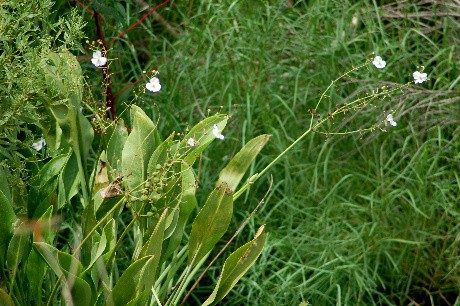 And what water’s edge would be complete without the unimposing common Water Plaintain?
And what water’s edge would be complete without the unimposing common Water Plaintain?
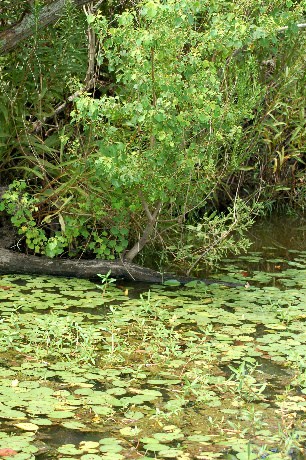 And of course there is an over-abundance of this non-native, invasive called Chinese Tallow–locally called “money tree”. Do you know why? I don’t!
And of course there is an over-abundance of this non-native, invasive called Chinese Tallow–locally called “money tree”. Do you know why? I don’t!
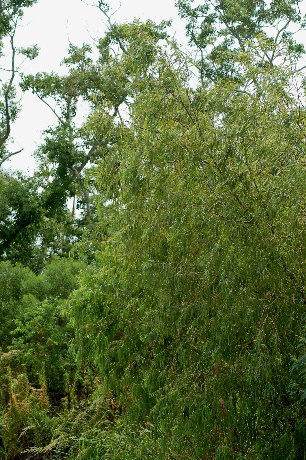 And we can’t have a serene water scene without a willow of some sort, can we?
And we can’t have a serene water scene without a willow of some sort, can we?
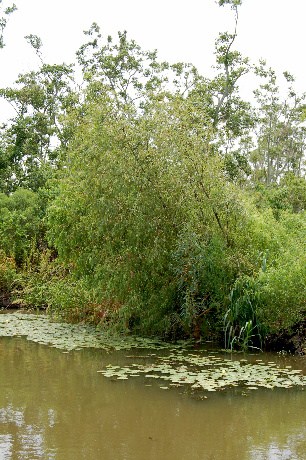 Would you happen to know what kind this is? If so, post a link so I can see!
Would you happen to know what kind this is? If so, post a link so I can see!
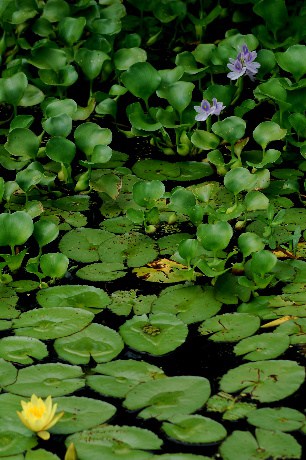 And then there’s this simple yet elegant example of native and non-native sharing the same space, thriving, yet competing in their own passive water ballet of symbiosis. And this is the photo that is going to win someone a nice, bright red T-shirt from Community Coffee. If you know what the purple flower is, take your best shot. Each correct guess will be entered in a random drawing this weekend. Oh, and if you’re a regular reader, it shouldn’t be too hard (that was a MAJOR hint!).
And then there’s this simple yet elegant example of native and non-native sharing the same space, thriving, yet competing in their own passive water ballet of symbiosis. And this is the photo that is going to win someone a nice, bright red T-shirt from Community Coffee. If you know what the purple flower is, take your best shot. Each correct guess will be entered in a random drawing this weekend. Oh, and if you’re a regular reader, it shouldn’t be too hard (that was a MAJOR hint!).
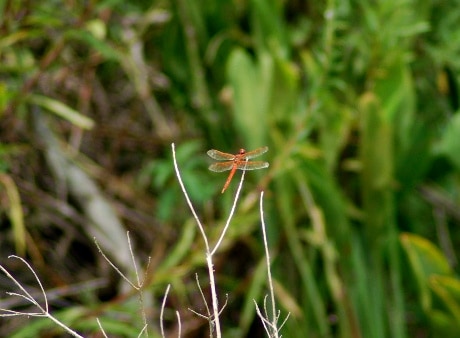 And my favorite visitor of the day, though Diane will tell you hers was a prettier blue, this red dragon fly. Do you know what this insect is called locally? I do!
And my favorite visitor of the day, though Diane will tell you hers was a prettier blue, this red dragon fly. Do you know what this insect is called locally? I do!
BW is off to a marsh grass planting at TE-44 and should be posting a comprehensive report of three such plantings, complete with photos and lots of mud!
Until then, tell your friends who love red T-shirts to come see me, and
keep those guesses coming!
BW

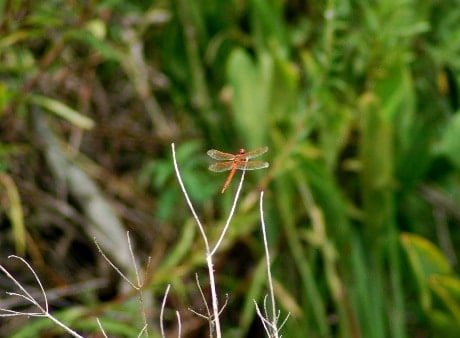




Good Morning BW!
I love red!
My guess would be: Water Hyacinth
My guess is water hyacinth. The tallow tree was imported to the US in the 1700’s as a money crop(tree).The first record of Chinese tallow introduction into the United States is found in a letter from Benjamin Franklin written in 1772 to Dr. Noble Wimberly Jones of the Georgia colony. Franklin wrote: “I send also a few seeds of the Chinese Tallow Tree, which will I believe grow & thrive with you. ‘Tis a most useful plant” Franklin thought he was doing his buddy a favor towards making him rich. How did that work out?
Oh yeah, there’s oil in the seeds. The bio-diesel crowd is considering using the seeds to produce enough oil to make bio-diesel!
I vote for water hyacinth. Also, you may not, but I grew up calling dragon flies – mosquito hawks!
(1) It’s a @#&% Water Hyacinth. (2) We also call them Mosquito Hawks. (3) before your next FISHING trip make a check list (and check it) AND last but not least…also check out Marinews.com. LOL!
Steffi – in my own defense, I hate check lists, yea well whatever. I walked past the ice chest twice and was so zoned out I just didn’t grab it. Besides, I was going to test my new steering and decided to grab a rod or 2. Also, Diane usually brings her cooler full of ice, and I invited her at the last minute, so she took off down here like a bat out of you know where and didn’t take time to load up. So, thanks for the check-list, and LilSis has been preaching that to me for quite a while now!!!!
I agree with the rest. Water hyacinth! You just posted a gorgeous photo a few days ago of them. I do think they are lovely even if they are extremely invasive.
I got fishing to do. I am headed to the Hoosier swamp. Hope the Lotus are blooming. I knew it weren’t no Canadian Soldier.
Are they true lotus? How big are the leaves? Do you ever gather the seed pods?
Not that big. You talking the shower head looking ones or ????
Seems to me one of these water flower seed things looks a bit like a
male reproductive thingie inside.
Had some purple flowers I never saw before. Spike like stalk.
Arrowheads live in shallow water right?
Camera knew fish weren’t biting and stayed home.
I was going to say Water Hyacinth also. We ususally have these at the camp. I’ve always thought they were pretty. Didn’t know they were invasive. I think ours have been crowded out by the more invasive giant salvinia.
Thank goodness we don’t have giant salvinia here!
Water Hyacinth: Scientific name: Eichhornia crassipes. If it makes you feel any better {tho I bet you arent really sweatin it…lol} I AM A LIST MAKER, and I STILL forget key items…lol. It happens. But we are alike in that when we find lemons, we happily make lemonaid, so in kind, thanks for the beautiful pics!
Yep, agree. That would be Water Hyacinth. Brought to Louisiana in 1884 via the Cotton Exposition held in New Orleans. It’s checked off on my checklist of Louisiana plants and wildlife that I must learn.
And Diane? Did it come from South America or Asia?
I understand from Wikipedia that it is native to the Amazon Basin. It was introduced by Belgian colonists to Rwanda to beautify their holdings and then advanced by natural means to Lake Victoria where it was first sighted in 1988.
It is being looked at for energy uses and is also used in some ways as a medicinal plant. From the way everyone says it multiplies, it should be make some cheap energy.
Never looked at this Cammy, since I pretty much accepted the history lesson I received over many years as to how it landed in Louisiana waters! Diane explained it pretty well!
Thought you might be interested to know, in today’s B.R. paper there was an article about the Water Hyacinth. It stated it was introduced to La. at The Cotton Exposition.
Yes, Steffi, that’s what I’ve been telling folks on my tours for several years now. I sure hoped it was correct!!!!
Well, from what I gather, the water hyacinth that originally made it’s way to south Louisiana was imported from Venezuela by the Japanese delagation attending the Cotton Exposition. It was supposedly given away to visitors, many of whom used it as an ornamental plant in garden ponds and the rest is history.
Excellent, little grasshopper!
Yes, Blu, “arrowheads” (also of the water plaintain family) live in shallow water or on soggy banks. The difference in the those and these are the leaves and stalks. This one is “sagittaria lancifolia” with the flower spikes being taller than the leaves. The one you mention is called “sagittaria latifolia” and the leaves are taller than flower spikes!!! Okay, I’m kinda showing off, but there are some things I am right about! This happens to be one of them. (I know, it’s rare.)
Why the H E double hockey sticks would a Japanese delegation bring an import from Venezuela? Do you think they had a crystal ball and paired up with an ulterior motive in mind? You know there was that thing about Hiroshima and now the “Gasoline” situation with Venezuela.
I like Dianes explanation better than Wikipedias too. A whole lot easier to understand also.
I just realized I have some of the water plantains (not sure which species) planted below my window AC. Mom brought them from one of her fishing holes a few years ago and told me that she called them a water lillie. Also, they need a marshy area to grow and were very beautiful when they bloomed. They have never bloomed but, the leaves are so tall and lovely. They die down in the winter and come back each spring. And being below the ACs drip makes them very happy. Wish they would bloom just once.
Hmmm. That’s interesting, Cammy. Wonder why they haven’t bloomed? Do they get sunshine?
Not a whole lot of direct sun. That side of the house has about an 18″ shade all the way down it from about 10am on thru the day. From what she had told me about them, they were in the shallows and under over hanging trees. Last year, the leaves shot up about 20″ tall. This year they were only about 12″. I guess the dry weather affected them.